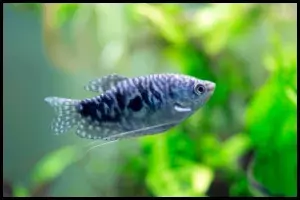
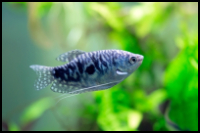

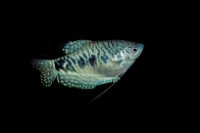
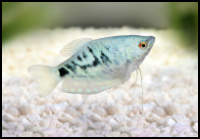
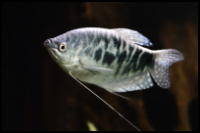
Quick Care Details (Table)
| Livestock Characteristics | Value |
|---|---|
| Care Level | Easy |
| Temperament | Semi-Aggressive |
| Diet | Omnivore |
| Maximum Size | 6 Inches |
| Minimum Tank Size | 30 Gallons |
| Plant Safe | Yes |
| Temperature Range | 72-82F |
| PH Range | 6.0-7.5 |
| KH Range | 4-18 |
Species Specific Categories
Helpful Video
Care Details
Aquascape for Opaline Gouramis: When designing an aquascape for Opaline Gouramis, aim to mimic their natural habitat. They prefer densely planted tanks with floating vegetation that diffuses light and provides hiding spots. Subdued lighting and dark substrate can accentuate their vibrant colors and reduce stress.
Substrate: Use fine gravel or sand as substrate to create a natural environment. Opaline Gouramis may sift through the substrate in search of food, so avoid using sharp or coarse materials to prevent injury.
Disease Prevention: Maintaining good water quality, a balanced diet, and stress reduction are key to disease prevention. Ensure regular water changes and monitor water parameters to keep your Gouramis healthy.
Filtration: Efficient filtration is crucial. Use a quality filter to maintain clean water. Gouramis can be sensitive to water quality, so invest in a reliable filtration system.
Lighting: Opaline Gouramis don't require intense lighting. Moderate, subdued lighting is ideal, especially if you have live plants in your tank. It helps replicate their natural habitat and reduces stress.
Water Flow: These Gouramis prefer slow to moderate water flow. Use filter outlets and plants to disperse water gently throughout the tank.
Hardiness: Opaline Gouramis are relatively hardy and suitable for beginners, but they can be sensitive to water parameters. Maintaining stable water conditions is essential.
Acclimation: When introducing new Opaline Gouramis to your tank, acclimate them slowly to prevent stress or shock. Gradually adjust water parameters over an hour or more before releasing them into their new environment.
Expected Lifespan: Under proper care, Opaline Gouramis can live for 4 to 6 years or even longer. Consistent water quality and a balanced diet contribute to their longevity.
Special Requirements: Opaline Gouramis have a labyrinth organ, so they require access to the water's surface to breathe air. Keep the water level below the tank's rim to allow them to reach the surface easily. Additionally, provide them with floating plants or structures near the surface where they can build bubble nests.
Temperament and Behavior
Behavior: Opaline Gouramis are known for their peaceful and gentle temperament, making them a great addition to community aquariums. They spend most of their time in the middle to upper regions of the tank and are generally calm and non-aggressive then other gourami species. They may occasionally engage in minor territorial disputes, especially during breeding.
Breeding: Breeding Opaline Gouramis can be an exciting endeavor. They are bubble nest builders, and males create nests at the water's surface. To encourage breeding, provide floating plants or a breeding mop near the surface. Once the male constructs the nest, he will court a female, and the pair will engage in an elaborate mating ritual. After spawning, the male guards the nest and fry until they are free-swimming.
Aggression: While Opaline Gouramis are generally peaceful, males can become territorial during the breeding process. They might display aggression toward other males and even females when guarding their bubble nests. However, this behavior is usually short-lived.
Tankmates Compatibility: Opaline Gouramis are excellent community fish. They get along with other peaceful species such as cardinal tetras, rasboras, danios, and non-aggressive bottom-dwellers like Corydoras catfish. Avoid keeping them with fin-nipping or aggressive fish, as their long, flowing fins can make them vulnerable.
Activity Level: Opaline Gouramis are moderately active swimmers. They enjoy exploring the middle and upper regions of the tank and may occasionally visit the surface to breathe air. They are not overly energetic but are delightful to watch as they gracefully glide through the water.
Schooling or Shoaling Behavior: These Gouramis do not exhibit traditional schooling behavior. However, they tend to be more comfortable and less stressed when kept in small groups of their own kind, typically one male and a few females.
Plant Compatibility: Opaline Gouramis are plant-friendly and won't typically damage live plants. In fact, they might appreciate the cover and security that plants provide. Consider adding live plants to your aquarium to create a natural and comfortable environment for them.
Diet and Nutrition
Dry Foods: Opaline Gouramis readily accept high-quality dry foods, such as flakes and pellets. These can serve as their staple diet, providing essential nutrients. Look for products specifically designed for tropical fish or Gouramis.
Frozen Foods: Offering occasional frozen foods like brine shrimp, daphnia, and bloodworms can be a great way to provide a varied and nutritious diet. Frozen foods are well-received by Opaline Gouramis and can help enhance their coloration.
Live Foods: Opaline Gouramis enjoy live foods, which are highly stimulating for their natural hunting instincts. You can occasionally offer live foods like small aquatic insects, mosquito larvae, or daphnia. Live foods can be especially beneficial during the breeding season, as they can trigger spawning behavior.
Vegetables: While Opaline Gouramis are primarily carnivorous, they may nibble on blanched vegetables like spinach or zucchini occasionally. These can be a good source of fiber and essential nutrients, promoting their overall health.
Algae: Opaline Gouramis are not known to be significant algae eaters. While they might graze on soft algae occasionally, it's not a substantial part of their diet. It's best to provide a balanced diet that includes other foods.
Feeding Schedule: Feed your Opaline Gouramis 2-3 times a day, but in small, measured quantities to prevent overfeeding. It's important to maintain a regular feeding schedule to keep them healthy. They have a relatively small mouth, so ensure the food is appropriately sized.
Supplemental Foods: To enhance their coloration and overall well-being, consider providing high-quality color-enhancing foods designed for tropical fish. These foods often contain natural color enhancers like astaxanthin and spirulina.
Tank Parameters
Tank Size: Opaline Gouramis thrive in aquariums with a minimum size of 20-30 gallons. A larger tank provides them with ample swimming space and helps reduce territorial disputes among multiple Gouramis.
Tank Length and Measurements: When setting up the aquarium, consider its length. A longer tank is often better than a taller one since Opaline Gouramis prefer horizontal swimming. The dimensions can vary but should accommodate their swimming habits.
Water Temperature: Maintain a stable water temperature in the range of 77-82°F (25-28°C). Opaline Gouramis are tropical fish and require warmer water for their well-being.
pH (Acidity/Alkalinity): Opaline Gouramis prefer slightly acidic to neutral water conditions. Aim for a pH level between 6.0 and 7.5 to create a suitable environment for them.
KH (Carbonate Hardness): A KH level of 2-15 dKH (degrees of carbonate hardness) is suitable for Opaline Gouramis. This range helps maintain stable pH levels and water chemistry.
GH (General Hardness): Opaline Gouramis tolerate a GH range of 5-12 dGH (degrees of general hardness). This ensures that the water has enough minerals to support their health.
Hardiness: Opaline Gouramis are generally hardy and can adapt to various water conditions, but it's essential to keep water parameters within the recommended ranges for their optimal health and well-being.
Nitrate (NO3) Levels: Keep nitrate levels below 20-30 ppm (parts per million) through regular water changes and efficient filtration. Elevated nitrate levels can stress the fish and lead to health problems.
History, Popularity, History and Species Variety Details
Table of Contents
The History, Popularity and Natural Habitat
Opaline Gouramis, scientifically known as Trichopodus trichopterus, are a popular freshwater aquarium fish with a rich history. Native to Southeast Asia, particularly in Thailand, Malaysia, and Indonesia, they inhabit slow-moving or stagnant waters such as swamps, streams, and rice paddies.
Their stunning appearance and peaceful temperament have contributed to their popularity among aquarists worldwide. Opaline Gouramis are closely related to the Blue Gourami and are often considered a color variant of the three-spot Gourami due to their shared characteristics. They are characterized by their iridescent scales that shimmer with shades of blue, green, and red, resembling precious opal stones, which inspired their name.
In their natural habitat, Opaline Gouramis are omnivores, feeding on a diet of small invertebrates, algae, and aquatic plants. They are labyrinth fish, meaning they possess a specialized breathing organ called a labyrinth organ, allowing them to gulp air at the water's surface. This adaptation enables them to survive in poorly oxygenated waters.
Opaline Gouramis' adaptability to various water conditions and their captivating colors have made them a favored choice for both beginner and experienced aquarists. They thrive in community tanks and can coexist peacefully with other non-aggressive fish, making them a delightful addition to any freshwater aquarium. Their vibrant colors and unique behavior, such as building bubble nests, add beauty and interest to home aquariums, making them a beloved species among aquatic enthusiasts.
Back to topSimilar Types of Gouramis
- Blue Gourami (Trichopodus trichopterus): The Blue Gourami is similar to the Opaline Gourami in terms of care and appearance, but it has a blue coloration, making it distinct.
- Gold Gourami: These Gouramis are characterized by their golden or yellow coloration. They have a peaceful temperament and are suitable for community aquariums.
- Three-Spot Gourami: As the name suggests, these Gouramis have three dark spots along their sides. They are slightly more aggressive than Opaline Gouramis.
- Sunset Gourami: Sunset Gouramis display a beautiful mix of colors, including orange, red, and yellow. They are a captivating addition to the aquarium.
- Dwarf Gourami (Trichogaster lalius): While not a variety of Opaline Gourami, Dwarf Gouramis are closely related. They are smaller in size and have distinctive patterns and colors, making them a popular choice among aquarists.
- Honey Gourami (Trichogaster chuna): These Gouramis have a bright golden-yellow coloration and are known for their peaceful nature. They are a bit smaller and can be kept in smaller tanks.
- Pearl Gourami (Trichopodus leerii): Another related species, Pearl Gouramis have a unique pattern of pearl-like spots on their bodies. They are peaceful and have distinctive fin shapes.
- Thick-Lipped Gourami (Trichogaster labiosa): These Gouramis have plump, thick lips and are known for their attractive colors. They share the same general care requirements as Opaline Gouramis.
Frequently Asked Questions
What's the ideal tank size for Opaline Gouramis?
Opaline Gouramis do best in tanks of at least 20 gallons, providing them with ample space to swim and explore.
What's their preferred water temperature and pH level?
Maintain a temperature between 75-82°F (24-28°C) and a slightly acidic to neutral pH of 6.0-7.5.
Are Opaline Gouramis suitable for beginners?
Yes, they are a great choice for beginners due to their hardy nature and peaceful temperament.
What should I feed them?
Opaline Gouramis are omnivores. They enjoy a diet of high-quality flake or pellet food, supplemented with live or frozen foods like brine shrimp, bloodworms, or daphnia.
Can they coexist with other fish?
Opaline Gouramis are generally peaceful and can live with other community fish. Avoid aggressive or fin-nipping species.
Do Opaline Gouramis need a planted tank?
While they don't require a heavily planted tank, they appreciate the presence of some live or silk plants for cover and comfort.
How can I tell the gender of Opaline Gouramis?
Males tend to be larger and more colorful, with longer dorsal fins. Females are plumper and have shorter, rounded dorsal fins.
Are they bubble nest builders?
Yes, Opaline Gourami males are bubble nest builders. They create and guard bubble nests during breeding.
What's their lifespan?
With proper care, Opaline Gouramis can live up to 4-6 years.
Are Opaline Gouramis prone to any specific diseases?
They can be susceptible to common aquarium diseases, so maintain good water quality and monitor their health regularly.

